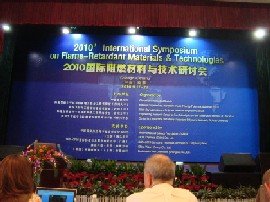2010 International Symposium on Flame-Retardant Materials & Technologies

The 2010 International Symposium on Flame-Retardant Materials & Technologies, ISFRMT 2010, September 17-20, 2010, took place in Chengdu, China. Organised by the Chinese Flame Retardant Society and the Sichuan University of Chengdu, this conference had around 250 attendants from China, other Asian countries, Europe and the USA. Speakers and audience mainly came from academia and industry (polymer and flame retardants producers).
The topics presented covered flame retardant mechanisms, new flame retardant systems, nanocomposites in flame retardancy, flame retardant thermoplastics, thermosets and coatings, fibres and textiles, elastomers and rubbers, commercial applications, toxicity and environmental aspects, and last not least, standardisation, regulations and testing. Eight keynote presentations, 25 papers were given and around 50 posters presented.
The main conference topic was on halogenfree flame retardant systems. Only a few papers covered new developments in halogenated flame retardants. The trends here are on polymeric flame retardants and new synergists instead of antimony trioxide.
Many papers dealt with phosphorous flame retardants and their mechanisms in the gas and condensed phase. New developments with DOPO (9,10-Dihydro-9-oxa-10-phosphaphenanthrene-10-oxide), its silicon and cyanuric acid derivatives were presented for applications in epoxies and polyester fibers. Phosphinates such as poly methylphosphonate (PMP) as epoxy hardeners, metal phosphinates in polyamides and PBT, as well as phosphazene derivatives in epoxies and melamine polyphosphate plus hyperbranched flame retardants were discussed.
Intumescence, inorganic flame retardants and nanoclays were other important topics in this conference. Intumescent systems based on ammonium polyphosphate, rare earths, natural silicates, silicon-based synergists or expandable graphite were discussed. The role of inorganic flame retardants to improve flame retardancy (metal hydroxides, boron compounds and zinc borate, stannates) was shown in several papers. Nanoclays (montmorillonite, sepiolite, double layered hydroxides LDH) were further dealt with; however, there contribution to flame retardancy is rather low.
Presentations on flame retarded biopolymers such as polylactic acid composites, chitin and alginic acid fibers, as well as new findings in the flame retardancy of conventional polyester and viscose fibers reflected the growing interest in these fields. New developments in flame retardant engineering plastics and blends (polycarbonate/LCP, PC/ABS, PBT, PA, PET) were shown in several papers.
The toxicity of fire gases from flame retarded plastics was further discussed; it was shown that flame retardants do not contribute to unusual high toxicity levels in fire effluents.
Finally, the latest status and trends for fire safety regulations and tests were presented. In the future, regulations and test will be increasingly globally used and fire safety requirements will grow.
The conference has shown that flame retardants, flame retardant polymers and textiles are a key topic in China for academic research and industry, and that substantial progress takes place in this field.
Conference details and programme are available under: http://chem.scu.edu.cn/ISFRMT2010/index_e.htm.